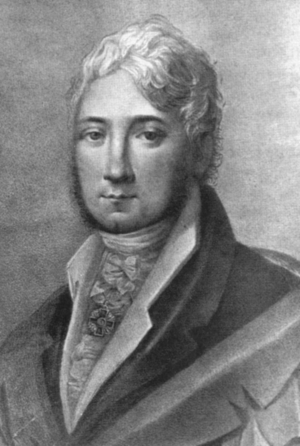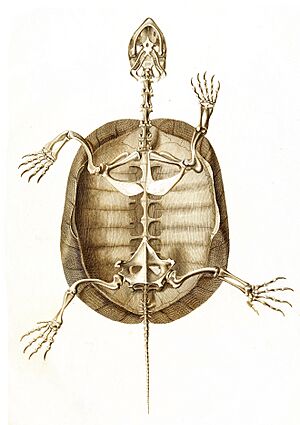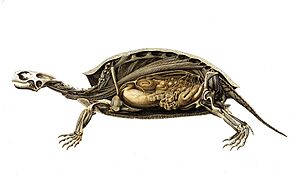Ludwig Heinrich Bojanus facts for kids
Quick facts for kids
Ludwig Heinrich Bojanus
|
|
|---|---|

Lithograph by Mateusz Przybylski in the Musée National de Lituanie, Vilnius
|
|
| Born | July 16, 1776 |
| Died | April 2, 1827 (aged 50) |
| Signature | |
Ludwig Heinrich Bojanus (born July 16, 1776 – died April 2, 1827) was a smart scientist from France and Germany. He was a physician (doctor), and he studied the bodies of animals. This is called comparative anatomy. He also studied natural history, which means he learned about plants and animals in nature.
Bojanus spent most of his working life teaching animal medicine (veterinary medicine) at Vilnius University. This university was in a place called Tsarist Russia back then. His most famous work was a big, two-book set about how turtles are built inside. This book, published in 1819 and 1821, focused on the European pond turtle. A special part inside some molluscs (like clams or snails) is named after him, called the Organ of Bojanus. Also, a very old mammal from the Triassic period, called Lisowicia bojani, was named to honor him in 2019.
Ludwig Bojanus: His Life Story
Ludwig Bojanus was born in a town called Bouxwiller in France. His family had to move to Darmstadt, Germany, in 1789 because of a war. He finished school there.
He then went to the University of Jena to study medicine. He became a doctor in 1797. In 1804, he was asked to be a professor of animal medicine at the University of Vilnius. He started teaching there in 1806.
In 1812, he had to leave Vilnius when Napoleon's army invaded. He went to St. Petersburg and came back to Vilnius in 1814. From then on, he also taught comparative anatomy. This means he compared the body parts of different animals. In 1822, he became the head of the university, called the rector. Two years later, he moved back to Darmstadt because he was not well. He passed away there on April 2, 1827.
Studying Animals: His Big Discoveries
Bojanus wrote about 70 different works on animal bodies and animal medicine. His most important work was a book with many pictures about the inside of turtles. This book was called Anatome Testudinis Europaeae. It came out in 1819 and 1821.
The book had 50 detailed drawings that Bojanus made himself. These drawings showed the inside of the European pond turtle. His student, Adam Ferdynand Adamowicz, said that Bojanus studied at least 500 turtles to make these amazing drawings!
Bojanus also found a special gland (a body part that makes liquids) in bivalve molluscs. These are animals like clams and mussels. This gland is now known as the organ of Bojanus, named after him.
In 1818, he noticed tiny worm-like creatures called cercaria inside snails. He thought they might be related to liver flukes, which are parasites. He didn't fully understand their life cycle, but he was on the right track!
He also described two types of ancient cattle: the aurochs (Bos primigenius) and the steppe wisent (Bison priscus). He helped scientists tell the difference between these two large animals that are now extinct.
Recognition and Memberships
Ludwig Bojanus was recognized for his important work by many science groups. In 1814, he became a member of the Imperial Academy of Sciences in St. Petersburg. In 1818, he joined the Imperial Leopold-Caroline Academy of Natural Sciences in Germany. Then, in 1821, he became a foreign member of the Royal Swedish Academy of Sciences. These memberships showed how much other scientists respected his discoveries.



